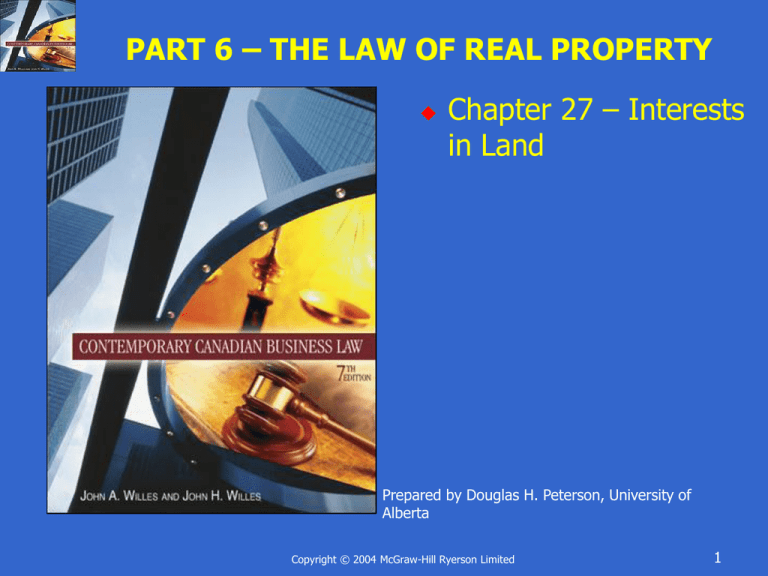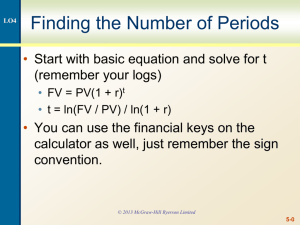
PART 6 – THE LAW OF REAL PROPERTY
Chapter 27 – Interests
in Land
Prepared by Douglas H. Peterson, University of
Alberta
Copyright © 2004 McGraw-Hill Ryerson Limited
1
INTERESTS IN LAND
Historical Development
Estates in Land
Interests in Land
Fixtures
Title to Land
Registration of Property Interests
Copyright © 2004 McGraw-Hill Ryerson Limited
2
INTRODUCTION
Interests in land takes many forms
Ownership
Leases
Property rights are commonly referred to as
“estates” in land
Property vs. Title – property is the thing
itself and title is legal interest in the thing
Copyright © 2004 McGraw-Hill Ryerson Limited
3
HISTORICAL DEVELOPMENT
Real Property – land anything permanently
attached to it
Common law
Real property includes buildings, that below and
that above
Carrot theory – center of the earth to the
heavens above
Today – reasonable depth and reasonable height
Crown often owns what is below
Fixture – a chattel that is constructively or
permanently attached to the land
Copyright © 2004 McGraw-Hill Ryerson Limited
4
HISTORICAL DEVELOPMENT
Real versus Personal Property
Distinction according to type of property and
rights in such property
Real = land and attachments
Immovable
Real – (“real action”) historically legal remedy a party
could get when rights to land had been interfered
with
Personal = chattels
Moveable
Personal action – action for money damages
Copyright © 2004 McGraw-Hill Ryerson Limited
5
HISTORICAL DEVELOPMENT
Feudal System
Land was granted by the Crown in return for promises
(Ownership remained with Crown)
land held by crown given to lords who held subject to
certain rights and duties – portions to vassals then subvassals subject to further rights and duties
Holder had to comply with promise to necessary armed
men or services in support of the crown
Other services such as Agricultural and administrative
Escheat – reversion of land back to the crown when the
promise underlying the grant was broken
Copyright © 2004 McGraw-Hill Ryerson Limited
6
HISTORICAL DEVELOPMENT
Types of Interest in Land
Estates
Estates
Non-possessory interests
Tenure – a method of holding land granted by the Crown
Was free or un-free
2 Main Principals of Ownership
Estates in time – time during which holder of interest has
exclusive right to possession of land
Interests less than estates – according to kinds of use
permitted or restricted upon the land
Copyright © 2004 McGraw-Hill Ryerson Limited
7
TYPES OF ESTATES
Nature of Estates
Exclusive right to possession for period of time
Fee Simple
Life Estate
Leasehold Estate
Copyright © 2004 McGraw-Hill Ryerson Limited
8
FEE SIMPLE
The right to use land subject only to local
restrictions
The highest level of land ownership
Unconditional ownership
Effectively amounts to complete ownership
May dispose immediately or after death
Generally unlimited use and abuse of property
Copyright © 2004 McGraw-Hill Ryerson Limited
9
FEE SIMPLE
Limitations on rights of ownership
Tort obligations associated with land
Government regulation
Environmental, planning, and zoning legislation
Expropriation
Nuisance, occupiers’ liability
Forced sale to government for public purpose
Requires compensation to fee simple owner
Crown rights reserved
Crown often reserves rights to minerals and certain
precious metals
Copyright © 2004 McGraw-Hill Ryerson Limited
10
FEE SIMPLE
Escheat – the reversion of land to the Crown
when a person possessed of the fee dies
intestate and without heirs
Deed – written or printed instrument effecting
legal disposition
Execution
Delivery
Copyright © 2004 McGraw-Hill Ryerson Limited
11
LIFE ESTATE
Right to possession is based upon a person’s
lifetime
An estate in land for the life of one person
Exclusive possession during lifetime
Life estate holder liable for waste
Waste and act that significantly affects value of
land
Protection of party with reversion or remainder
Copyright © 2004 McGraw-Hill Ryerson Limited
12
LIFE ESTATE
No right to dispose of property on death
Reversion to party with fee simple
Remainder to person selected by party with
fee simple
Reversion – the balance of fee simple reserved
to the grantor and her heirs at the end of a life
estate
Remainder – the balance of a fee simple that
goes to a third person at the end of a life estate
Remainder person - a person who holds the
reversion or remainder in a fee simple
Copyright © 2004 McGraw-Hill Ryerson Limited
13
INTERESTS IN LAND
EXAMPLE OF CREATION OF ESTATES IN LAND
Copyright © 2004 by McGraw-Hill Ryerson Limited.
“Owner” of All Land
CROWN
Grants Estate in Fee
Simple to a Person
FIRST
GRANTEE
‘A’
Has Fee Simple
May Grant Lesser
Estate (Life Estate) to
‘B’
‘B’
Remainder After
Grant of Life
Estate May Be
Granted to ‘C’
‘C’
Copyright © 2004 McGraw-Hill Ryerson Limited
On Death of ‘B’ Life
Estate Ends and B’s
Remainder and Life
Estate Merge to Form
Fee Simple Again in ‘C’
‘C’
Has Fee
Simple
14
LEASEHOLD ESTATE
Land leased to a tenant for a definite period
of time
Right to exclusive possession for specified period
Period must be stated with certainty at outset
Compare life estate: uncertain duration of life
Nature of leases
Examined below
Copyright © 2004 McGraw-Hill Ryerson Limited
15
THE CONDOMINIUM
Mixed estates (joint control)
Individual ownership and shared ownership
Individual (fee simple)– single unit
Common – (tenants-in-common) common areas
such as pool, gym, recreation center
Common law
Property ownership either horizontal or vertical
plane
Property rights above and below the ground
“Air rights” and “strata title”
Copyright © 2004 McGraw-Hill Ryerson Limited
16
THE CONDOMINIUM
Required documentation varies by province
Declaration; strata plan; condominium plan
Exclusive use area
Common use area
Co-ownership of common elements tied to
ownership of individual unit
If title to individual passes so does interest in
common elements
Cannot sever the two
Copyright © 2004 McGraw-Hill Ryerson Limited
17
THE CONDOMINIUM
Condominium Corporation – a corporation –
whose members are the condominium
owners
Responsible for managing the property as a
whole
Management financed by condominium fees
Investment risks
Maintenance of a condominium
Insurance
Copyright © 2004 McGraw-Hill Ryerson Limited
18
CO-OPERATIVE HOUSING CORPORATIONS
Cooperative Housing – alternative to
condominiums
Member buys a share in cooperative
organization and by virtue of equity gets a unit
in development
Corporation, as owner of building, is responsible
for maintenance and payment of mortgage
Copyright © 2004 McGraw-Hill Ryerson Limited
19
INTERESTS IN LAND (EASEMENT)
Easements - a right enjoyed by one
landowner over the land of another for a
special purpose but not for occupation of the
land
Right to use neighbor’s land
Positive
Allows one party to do something
Negative
Prohibits one party from doing something
Copyright © 2004 McGraw-Hill Ryerson Limited
20
INTERESTS IN LAND (EASEMENT)
Right of way – an easement that gives the
holder a right to pass back and forth over
the land of another in order to get to and
from her own land
Dominant tenement – the piece of land that
benefits from an easement
Servient tenement – the land subject to the
easement
Copyright © 2004 McGraw-Hill Ryerson Limited
21
INTERESTS IN LAND (EASEMENT)
Acquisition of Easement
Express grant: agreement between parties
Implied by law: necessary for practical
convenience
Prescription: long, open, and uninterrupted use
of a right of way
Landlocked
Use visible and apparent
Statutory: public utilities
Copyright © 2004 McGraw-Hill Ryerson Limited
22
INTERESTS IN LAND (RESTRICTIVE
COVENANT)
Negative covenants limiting the use of land
Owner some control over use of property even
after it has been sold to another
A covenant requiring the holder of the land to
refrain from certain conduct or certain use of the
land
Need dominant tenement and servient tenement
Copyright © 2004 McGraw-Hill Ryerson Limited
23
INTERESTS IN LAND (RESTRICTIVE
COVENANT)
Issue: enforcement of covenants on
subsequent holders of the land (rule of
privity)
Covenants run with the land
Must be reasonable and not against public policy
Copyright © 2004 McGraw-Hill Ryerson Limited
24
INTERESTS IN LAND (DIFFERENCES)
Easement and Restrictive Covenants
Restrictive covenant
Is contractual
Must limit servient’s use of the land
Easement may arise from implication or prescription
Easement
Easement may allow dominant’s use of land
Copyright © 2004 McGraw-Hill Ryerson Limited
25
INTERESTS IN LAND (MINERAL RIGHTS)
Right belongs to owners in fee simple
Crown often reserves rights to minerals
Profit a Prendre – an interest in land
permitting the lessee to remove material
extracted from the ground
Copyright © 2004 McGraw-Hill Ryerson Limited
26
INTERESTS IN LAND (MINERAL RIGHTS)
Mineral eases
Right to extract and retain minerals from under
the surface of land occupied by others
Several interests in one agreement
Usually accompanied by a right to possession of
small area of land
No ownership of minerals until actually extracted
Usually acquired from government
Private fee simple generally excludes minerals
Copyright © 2004 McGraw-Hill Ryerson Limited
27
RIPARIAN RIGHTS
Riparian owner
Person who owns land adjacent to a
watercourse; or
Has land through which a natural stream flows
either above or below surface
Right to take water
Restriction
Cannot interfere with the downstream flow
Copyright © 2004 McGraw-Hill Ryerson Limited
28
POSSESSORY INTERESTS IN LAND
Adverse possession – a possessory title to
land under the registry system
Acquired by continuous, open, and notorious
possession of land inconsistent with the title of
the true owner for a period of time (usually 10 –
20 years)
Possessory title good against everyone, including
true owner
Need not be the same occupant continuously
Copyright © 2004 McGraw-Hill Ryerson Limited
29
ENCROACHMENTS
Encroachment – a possessory right to the
property of another that may be acquired by
the passage of time
Overhanging roof, building over the property line
If true owner permits encroachment for a long
period of time, right to demand removal is lost
Copyright © 2004 McGraw-Hill Ryerson Limited
30
FIXTURES
Fixtures – chattels that are permanently or
constructively attached to real property
Issue: fixture or removable chattel
Traditional Rule
Use and enjoyment
Chattel attached to improve the land became part of
the land
Chattel attached for the better use of chattel not a
fixture
Copyright © 2004 McGraw-Hill Ryerson Limited
31
FIXTURES
Factors – reviewed on a case by case basis
Attached by own weight or affixed to land
Can be removed without damage
Degree of annexation
Object of annexation
Can be removed without damage
Use of the chattel
Tenants – different rules
Can remove trade fixtures
Display cabinets, shelving, signs, mirrors, equipment,
and machinery
Copyright © 2004 McGraw-Hill Ryerson Limited
32
TITLE TO LAND
Tenancy in Common – concurrent holders of
equal shares in an estate
No right of survivorship
Interests not necessarily equal
Joint Tenancy – concurrent holders each of
whom has a right of survivorship
Undivided interest
Identical in time, interest, possession
Right of Survivorship – the right of a surviving
tenant to the interest of a deceased joint tenant
Copyright © 2004 McGraw-Hill Ryerson Limited
33
REGISTRATION OF PROPERTY INTERESTS
Two Systems
Registry Systems – registry office – searches
of the title to a piece of land
Bona fide purchaser – a purchaser who buys the
land without knowledge of an unregistered claim
No assurance of validity of interests
Purchaser must search title and bears risk of
“good chain of title”
Title insurance common protection for mistakes
Copyright © 2004 McGraw-Hill Ryerson Limited
34
REGISTRATIONS OF PROPERTY INTERESTS
Land Titles System
(Torrens System) – a system of land registration
where the land titles office brings all outstanding
interests in the land up to date and certifies
them as being correct
Certificate cannot be defeated
Guaranteed by government
All interests on certificate are valid
No other interests are valid
Insurance - compensation for mistakes
Copyright © 2004 McGraw-Hill Ryerson Limited
35
SUMMARY
Real Property
Includes land and attachments
Various Interests
Estates
Non-Possessory Interests
Fee Simple, Life Estate, Leasehold Estate
Joint tenancy, tenancy-in-common
Easement, right of way, restrictive covenant
Adverse Possession
Interests registered
Copyright © 2004 McGraw-Hill Ryerson Limited
36



